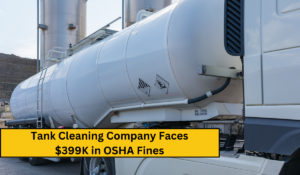Hydrogen sulfide (H2S) is a colorless, highly toxic gas with a distinct rotten egg odor, also known as ‘sewer gas’. In occupational settings, it poses a severe threat to workers when encountered in high concentrations, making respiratory protection in confined spaces especially critical.
Inhalation of this gas can lead to a range of adverse health effects, including irritation of the eyes, nose, and throat, as well as symptoms such as headaches, dizziness, and nausea. Of course, prolonged exposure to elevated levels of hydrogen sulfide can result in more severe consequences, including respiratory distress, loss of consciousness, and, in extreme cases, even death.
Ensuring adequate respiratory protection in confined spaces is essential in safeguarding the health and well-being of workers in environments where hydrogen sulfide may be present.
In a recent incident, two employees faced a grave danger when exposed to hydrogen sulfide gas during a cleaning operation in Texas. Unfortunately, what should have been a routine procedure ended up sickening several individuals, resulting in more than $399K in OSHA penalties.
This incident highlights the critical importance of adequate respiratory protection in confined spaces of hazardous work environments.
Here, we’ll break down the details of the incident, the subsequent investigation, and the vital lessons that can be learned to prevent such incidents at your worksite.
Related Article: Respiratory Protection Failures Lead to Worker’s Death
Related Article: Key Benefits of a Workplace Respiratory Protection Program

Respiratory Protection Failures
On April 25, 2023, in Beaumont, two employees of a tank cleaning company and two municipal firefighters responding to the scene suffered injuries due to hydrogen sulfide exposure.
The subsequent investigation conducted by OSHA revealed critical lapses. These included:
1. Inadequate Respiratory Protection:
The employer failed to provide sufficient respiratory protection to employees, leading to two workers requiring hospitalization.
2. Lack of Hazard Evaluation:
The employer failed to assess the worksite for potential respiratory hazards, neglecting to anticipate and mitigate risks.
3. Failure to Monitor Exposure:
The company did not implement measures to monitor employees for exposure to hazardous substances, leaving them vulnerable to potential dangers.
4. Deficient Respirator Program:
The required respiratory protection program, including medical clearances for respirator use and fit testing, was not effectively managed.
Penalties and Citations
OSHA responded with a comprehensive citation, proposing penalties totaling $399,349.
This citation encompassed nine health violations, including two willful, three repeat, and four serious infractions. These penalties underscore the gravity of the lapses in safety protocols.
The company has 15 business days from receipt of citations and penalties to comply, request an informal conference with OSHA’s area director, or contest the findings before the independent Occupational Safety and Health Review Commission.
Repeat Offender
Unfortunately, this company’s past disregard for safety standards extend beyond respiratory protection in confined spaces.
The business was also cited for recurring violations related to protective clothing, eye, face, and hand protection, labeling of containers, and timely submission of injury and illness logs to OSHA.
These repeat violations occurred at facilities in Georgia, Louisiana, and Texas over the past five years.
Preventative Measures
This incident serves as a stark reminder of the critical role respiratory protection plays in ensuring worker safety, particularly in environments with potential respiratory hazards.
Employers, especially those in industries involving hazardous substances, must prioritize the following:
- Conduct thorough hazard evaluations and implement appropriate controls.
- See OSHA Guidelines on Hydrogen Sulfide- hazards
- See OSHA Guidelines on Hydrogen Sulfide- Evaluating and Controlling Exposure
- Provide and maintain adequate respiratory protection equipment.
- See OSHA Guidelines on Respiratory Protection
- Establish and manage a robust respiratory protection program, including fit testing and medical evaluations.
- See OSHA Guidelines on Hydrogen Sulfide in Workplaces
- See OSHA Standards on Hydrogen Sulfide
- Regularly monitor employees for potential exposure to hazardous substances.
Need for Respiratory Protection in Confined Spaces
Respiratory protection in confined spaces is paramount for safeguarding the health and safety of your workers.
Because these locations often result in areas of poor ventilation & higher concentration of toxins, respirators serve as a critical barrier against inhaling hazardous gases, fumes, or contaminants present in these enclosed environments.
By providing a reliable shield for the respiratory system, it minimizes the risk of acute or chronic health issues associated with exposure to harmful substances.
Moreover, effective respiratory protection enables workers to carry out their tasks with confidence and focus, knowing that their well-being is prioritized. This, in turn, enhances overall productivity and efficiency in confined space operations.
Key Takeaways
This incident underscores the non-negotiable need for stringent respiratory protection measures.
It is incumbent upon employers to prioritize worker safety and comply with industry-recognized safety and health standards.
By doing so, you can prevent such incidents and create a workplace that prioritizes the well-being of your most valuable asset – your workforce.
Additionally, it assures compliance with regulatory standards, reducing the likelihood of costly fines or legal repercussions. Ultimately, investing in proper respiratory protection not only preserves the physical health of workers but also upholds the integrity and reputation of your workplace as a safe and responsible environment.
About Worksite Medical
In most cases, OSHA requires medical surveillance testing, and at no cost to employees.
Worksite Medical makes that program easier with mobile medical testing.
We conduct on-site respirator fit tests, as well as audiometric exams, pulmonary function tests and heavy metal lab work, right on your job site. We also keep accurate, easy-to-access medical records for your convenience. You’ll keep your employees at work, and stay ahead of OSHA inspections.




